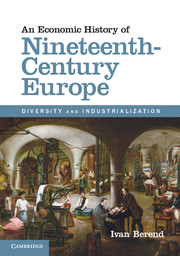Book contents
- Frontmatter
- Contents
- List of boxes
- List of figures
- List of maps
- List of tables
- Preface
- Introduction
- Part I Gradual revolution
- Part II Successful industrial transformation of the West
- Chapter 2 Knowledge and the entrepreneurial state
- Chapter 3 Agriculture, transportation, and communication
- Chapter 4 The organization of business and finance
- Chapter 5 Three versions of successful industrialization
- Chapter 6 The miracle of knowledge and the state: Scandinavia
- Chapter 7 Demographic revolution, transformation of life, and standard of living
- Chapter 8 The Europeanization of Europe
- Part III The peripheries: semi-success or failure of modern transformation
- References
- Index
Chapter 3 - Agriculture, transportation, and communication
from Part II - Successful industrial transformation of the West
Published online by Cambridge University Press: 05 December 2012
- Frontmatter
- Contents
- List of boxes
- List of figures
- List of maps
- List of tables
- Preface
- Introduction
- Part I Gradual revolution
- Part II Successful industrial transformation of the West
- Chapter 2 Knowledge and the entrepreneurial state
- Chapter 3 Agriculture, transportation, and communication
- Chapter 4 The organization of business and finance
- Chapter 5 Three versions of successful industrialization
- Chapter 6 The miracle of knowledge and the state: Scandinavia
- Chapter 7 Demographic revolution, transformation of life, and standard of living
- Chapter 8 The Europeanization of Europe
- Part III The peripheries: semi-success or failure of modern transformation
- References
- Index
Summary
The agricultural revolution
During the long nineteenth century, most European countries duplicated in varying degrees the earlier social and agricultural transformations of the Northwest. In the early nineteenth century, Dutch and British yields of the four main types of grain were twice as high as they were in continental Western Europe.
As had happened in the Northwest, revolutionary reforms replaced feudal institutions with modern ones on the continent. Serf labor was supplanted by free farmers or/and mobile wage labor. In the southern Low Countries (later Belgium), all seigniorial claims and obligations were abolished without payment in 1793. When the region became part of France in 1795, the government confiscated church lands and sold them to private farmers. Indeed, the Revolution created an owner-entrepreneur farmer economy in France: of the country's 3.8 million peasants, 68 percent had become independent farmers by 1851. The French reclaimed previously uncultivated land such as marshes, and built drainage systems that made cultivable vast swaths of river valleys and coastal regions.
The French occupation of northern Italy during the Napoleonic era abolished the last remnants of feudal rights; the sale of communal and church land increased the number of peasant proprietors, in some regions by 20 percent. Uniquely, Lombardy inherited from earlier periods (as had Belgium and the Netherlands) a highly developed capitalistic agriculture with an efficient irrigation system and specialized agricultural production.
- Type
- Chapter
- Information
- An Economic History of Nineteenth-Century EuropeDiversity and Industrialization, pp. 119 - 151Publisher: Cambridge University PressPrint publication year: 2012

